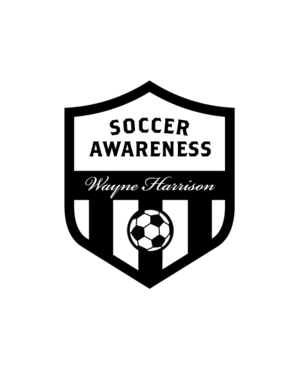The Three Team Awareness One Touch Game
/The following clinic is part of the New "Soccer Awareness Age Group Specific Awareness Developmental Training" eBook from Soccer Awareness! Click here to preview the full table of contents!
Working with three teams (numbers depends on how many players you have, e.g. it can be 4 v 4 + 4 or 5 v 5 + 5 etc). Teams (1) and (2) work together to keep the ball from team (3). If team (3) regains possession the team who gave it away becomes the defenders. The defenders reward is they keep the ball and link with the other team.
Rules: Once possession is gained, to establish who gave the ball away the player who gave the ball away calls the color of his team and then everyone knows they are now defending and the game continues without a stoppage.
With younger players it may be best to do this (because the ball may be given away a lot more for one thing); whoever won the ball puts his or her foot on the ball to stop play and the coach can call out the team who gave it away. Play begins again working on transitions.
Develop: Increase difficulty for attackers by
Reducing the zone size.
Decreasing the number of touches on the ball of each player.
Conditioning the passing to be only to the other attacking team’s players e.g. (1) only passes to (2) and vice versa, therefore only half the numbers of passes are available per player.
Using two balls so that as they pass one ball they are now increasing their awareness and vision by looking for the other ball coming.
Players take off their pinnies so they really have to look and can’t rely on color identification.
No talking or pointing, so players have to rely on their own vision.
Prohibiting verbal communication
ULTIMATELY PLAY ONE TOUCH
Three Team Possession Game
Three teams, two teams work together, one defends, creates an overload situation in attack, for example 15 players, three teams of 5, a 10 v 5 game.
Possession changes as one of the two team’s players gives the ball away to the defending team then they become the next defending team this is a good transition game also from attack to defense and defense to attack. This game can be in an area of 40 x 40 yards for example and the challenge to the players can also be to move inside to outside (outside being just inside the touchline) and outside to inside to ensure they avoid standing in one area. Plus it takes greater vision or awareness inside the area; where they need to look around and open their stance up to potentially change the direction of play; than on the outside where they can see everything easily.
Encourage players who play centrally on the team to get in the middle of the area and dictate the play, be the pivot for the team, the player who transfers the ball from one side to the other, the link player, this can be one, two or even three players at a time, but they can rotate between themselves too.
Equal numbered teams in a possession keep away game; this would be the next progression from the overload game being a more difficult challenge of the players. Same principles and ideas as above apply.
Transition games: In two halves, creating overloads in each half as each team gains possession. Team A have to get the ball in one half and play a 7 v 3 for example, team B have to win it back with the 3 defenders and get it back to the other half and have a 7 v 3 in their favor, and so on.












With this 94 page eBook, we are taking the Soccer Awareness thinking process to the next level by identifying what is relevant at each age group. That said, you the coach, will decide perhaps a 9 year old team can cope with the 11 year old sessions and perhaps a 12 year old lower level team will need to use younger age group session plans.
We hope you enjoy these sessions and as always our Soccer Awareness training material is simple to understand, user friendly and we try to offer a great attention to detail.
Feedback is always welcome as we want to keep improving our product.
Best wishes, Wayne Harrison